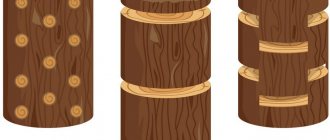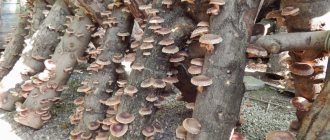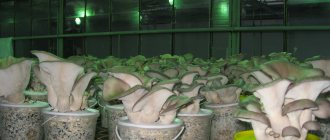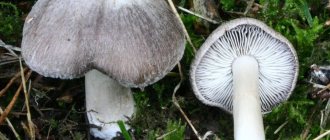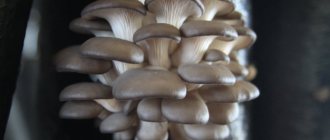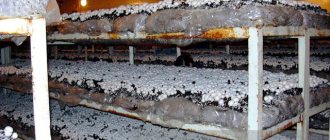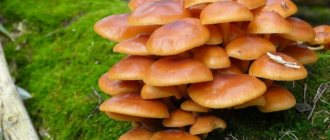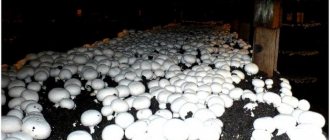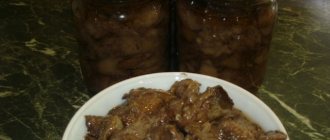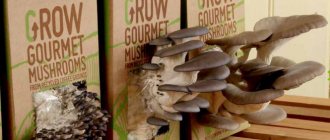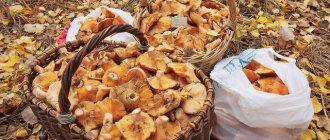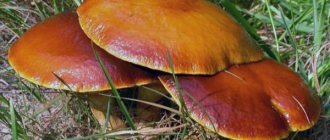Who doesn't love dishes made from aromatic mushrooms? But as soon as we want to enjoy mushroom soup, we don’t always want to go to the nearest supermarket for the main component. If only you could grow mushrooms right on the windowsill! Most of us become familiar with the concept of “mushroom mycelium” in school biology lessons. But many still fail to fully understand what mycelium is, why it is needed and how to get it yourself. These are the questions we will try to understand today.
What is mycelium
And yet, what is it? What is this mysterious substance with an unusual name? This is nothing more than the most common mycelium or the vegetative body of a mushroom culture. It consists of numerous thin fibers (hyphae), the structure includes nuclei (if the mycelium is coenotic) or septa (for mycelium of a septate nature).
Today, growing mycelium is possible even in a city apartment, thanks to which we have the opportunity to grow mushrooms at home.
How to get high-quality mycelium
Before you start cultivating mushrooms, you need to know where to get mycelium from. The highest quality mycelium is obtained in laboratories . This product can be bought in specialized stores with good reviews.
If desired, you can grow mycelium at home yourself, by properly preparing the substrate, ensuring comfortable environmental conditions and sanitation. It is quite possible to implement this idea.
Wooden chops with mycelium in original packaging
The main requirement for successful cultivation of mushrooms at home is compliance with temperature conditions, lighting and cleanliness.
Obtaining mycelium with your own hands is a suitable method for novice mushroom growers, because it gives you the opportunity to try the method on a small batch and without high costs.
Main types
Before growing mycelium, be sure to decide what type of mushroom medium you are going to prepare. We have more or less figured out the fact that mushroom mycelium may differ in its internal structure, but this is far from the only possible difference. Another fundamentally important classification is known, which distinguishes myceliums in accordance with what is the nutrient medium for them. Here they distinguish liquid, substrate or grain-based mycelium.
You can obtain mycelium of any type yourself, but each of them has both undeniable advantages and certain disadvantages. For example, myceliums based on a substrate grow relatively slowly, but are stored for a long time, grain mycelium is capricious - it has difficulty taking root on wood and does not have a long shelf life, and not everyone can prepare liquid mycelium - it requires skills and abilities.
Forms and functions
The forms of mycelium are very diverse and are characterized by a diverse structure, which can affect its main functions.
| Form | Components | Peculiarities |
| Film mycelium | It is represented by dense and flat plexuses of hyphae, which can differ in different sizes, thickness and coloring | Promote attachment to the substrate and, through enzymes, act destructively on cellulose, causing its absorption |
| Mycelium-cord | Formed by fused filamentous, short-branched or long, highly branched hyphae | Designed for attachment to substrate and spreading |
| Rhizomorph | A powerful formation, up to five meters long, consisting of dark-colored, dense type of outer hyphal filaments, complemented by internal light and loose cords | Designed for attachment to substrate and spreading |
| Rhizoctonia | Air type thin cords | Attachment to substrate and propagation |
| Sclerotia | A very dense type of plexus of hyphae containing a significant number of thread-like branches that form during fruiting | Helps facilitate adaptation to unfavorable growing conditions |
| Stroma | Flat type, sufficient density of fusion with the tissues of the host plant | Helps preserve fungal spores |
| Fruiting body | Vary in shape, color and size | Sporulation formations |
Unlike plant roots, fungal mycelium can be located not only in the soil, but also on the surface. In lower fungi, the mycelium is characterized by a noncellular structure, while in higher fungi it is multicellular.
Growing technology and necessary conditions
An important condition for successful production is air humidity and temperature conditions. The room must be humid and a constant temperature must be maintained (in the range from +20 to +30 degrees). It is also necessary to take care of ventilation and lighting.
Obtaining mycelium is an individual process, so there are no specific universal recommendations; each mushroom picker has the right to choose the method that best suits him.
Grain mycelium
Growing mushroom mycelium of champignons from a grain medium involves the following most common home recipe:
- Place the grain mixture in a large metal container and cover with water (so that the mixture is immersed 2-3 cm).
- Boil for half an hour.
- After this, the grain is filtered and dried on a flat, dry surface.
- The dried grains are poured into glass jars, filling them halfway, and sterilized for some time.
- When the jars of grain have cooled, you need to place a little prepared mycelium in each jar.
The fact that mycelium is developing will be indicated to you by the appearance of whitish fluff on the surface of the grains approximately three days after planting. After another week, the mycelium can be planted in the block.
Mycelium from mushroom stems
You can grow champignon mycelium with your own hands using mushroom stems and ordinary available cardboard - in fact, this is the same wood, so it will be easier for the mycelium to adapt to a permanent place.
Let's look at how to grow champignon mycelium this way:
- We take corrugated cardboard without any inscriptions and soak it in water at room temperature for at least 1 hour.
- We make longitudinal cuts on the mushroom stem and divide it into fibers.
- In the container where such an improvised “farm” will be located, we make drainage holes to remove excess moisture.
- We remove the top layer from the soaked cardboard, lay down the mushroom fibers, cover with the removed part and send it to the prepared container, placing a small press on top of the cardboard.
- The container with the mycelium is covered with plastic wrap; the cardboard needs to be ventilated from time to time and moistened with a spray bottle as soon as signs of drying appear.
After a few weeks, the sheet of cardboard will completely turn white and become overgrown with fibers - this means that the mycelium is ready and can be placed in the nutrient mixture.
If you still have questions about how to make mycelium, we recommend subscribing to Mikha Donetsky’s YouTube channel - there is a lot of information on how to grow mycelium and care for seedlings.
How to treat mycelium threads
It may give the misleading impression that fungal diseases are of little danger and that often only the cosmetic condition worsens. This is far from true; in advanced cases, serious complications may develop. In this regard, it is advisable to treat mycoses only under the supervision of a doctor in the specialty corresponding to the disease: dermatovenerologist, infectious disease specialist, dentist, etc.
Drug therapy
Treatment of mycelial threads is mainly carried out at the etiological level; symptomatic therapy is aimed at relieving itching, hyperemia, and mental stress. When a secondary infection occurs, the use of antibacterial drugs is indicated. Modern medicine has a large number of antifungal agents:
- Polyenes: Nystatin, Levorin - for the treatment of candidiasis;
- Amphotericin, Natamycin are broad-spectrum drugs.
- Terbinafine is an antimycotic for the treatment of onychomycosis, a skin fungus;
- Clotrimazole, Miconazole, Oxiconazole - treatment of various forms of candidiasis, trichophytosis, microsporia, epidermophytosis.
Hardware treatment
Hardware treatment of nail fungus is carried out using a laser. Physiotherapy is especially effective as part of combined treatment of the fungus, since in the absence of drug therapy there remains the possibility of insufficient eradication of the pathogen, which will cause a relapse of the disease. In addition, hardware methods include medical pedicure: the fungal mycelium is removed from the nails mechanically, after which antimycotic agents are applied in the form of varnishes.
Folk remedies
Turning to the experience of traditional medicine is less preferable than treatment with medications. In any case, consultation with a specialist is recommended. You can try to treat mycelium on the skin and nails with:
- water and alcohol solutions of propolis: baths or compresses.
- onion and garlic: the affected areas of the skin are smeared with juice, lotions are applied to the nails.
- treatment with birch tar.
Oyster mushroom mycelium at home: stage one
To obtain royal mycelium, parts of the fruiting body of fresh mushrooms are taken. The oyster mushroom needs to be divided in half and a small piece cut out from the stem. Then it must be dipped in a solution of hydrogen peroxide for disinfection - the material is ready for planting in a nutrient medium.
Then the treated piece is placed in a container with a nutrient substance and closed with a stopper disinfected by fire. Such home production of oyster mushroom mycelium requires mandatory sterility, therefore, after processing, the material should not be touched with hands, but taken with auxiliary tools; the room must also be kept clean.
A closed container with seedling material placed inside in an inclined position is left in the dark for a couple of weeks.
The nutrient medium in this production can be agar from wort, carrots, oatmeal, potatoes or glucose. After preparation, it is sterilized, poured into containers and waited for it to harden, after which a piece of mushroom is added.
What and in what to grow mushrooms in an apartment
To grow mushrooms in an apartment, you need to purchase or independently make a special nutrient substrate for them, since these mushrooms do not grow in ordinary soil, and simply “sowing” them in a pot of soil will not work.
Various bulk materials are used as a substrate in apartment conditions - buckwheat or sunflower husks, chopped branches and dry corn stalks, straw chaff, wood chips and even sometimes just cotton wool. But most often - sawdust or hardwood shavings.
Before planting the mycelium, such finely chopped substrate must be prepared. The goal is to sterilize it, saturate it with moisture and make it breathable. Usually the substrate is treated with boiling water or hot steam for about half an hour, and then dried. A well-moistened material ready for planting mycelium will “spring” when squeezed in the palm of your hand, but the water will not protrude out. You can also buy a ready-made clean substrate for mushrooms at a garden store.
To increase the nutritional value of such substrates, it is sometimes recommended to add dietary supplements to accelerate growth (sold in the same stores as the mycelium), grain and bran of cereal crops (wheat, barley, rice, millet), coffee cake, chicken manure, legume seed flour , urea, superphosphate or other sources of organic nitrogen and carbohydrates in an amount of 10-30% of the total volume of the substrate.
As for containers for growing mushrooms, there are options here too:
- For champignons and honey mushrooms, plastic-lined wooden boxes about 20-30 cm high, buckets or plastic bags are suitable.
- Oyster mushrooms and shiitake are grown in thick plastic bags or bags of 5-15 liters, in the walls of which cuts 3-4 cm long are previously made.
The first method of preparing potato agar
The estimated yield of the substance is 1 liter.
Ingredients: 300 g potatoes, 20 g agar (found at relevant medical laboratory supply organizations, health food stores or Asian food markets), 10 g dextrose or some other sugar, 2 g brewer's yeast (you can also use without them).
Work process.
Step 1. Before making agar for mycelium, you need to boil the potatoes with 1 liter of water for 1 hour. Next, remove the potatoes, leaving only the broth.
Step 2. Mix the broth, agar, sugar and yeast (if you are using them) thoroughly, for example, using a whisk; this mixture should not be beaten.
Step 3. Pour the resulting mixture into bottles or flasks to half or three-quarters of their volume.
Cover the necks with cotton swabs and wrap with aluminum foil. Pour water into the pressure cooker so that its layer from the bottom of the cookware is 150 mm, and install a grid on which to place bottles or flasks. Cover the dish with a lid and snap the latches.
Step 4. Place the steamer on the fire and wait until steam comes out. After ventilation for several minutes (depending on the specific model and in accordance with the instructions), close the valve. Bottles are boiled at 121 °C (1 atm) for 15 minutes. In this case, you need to ensure that the temperature does not exceed this level, because in this case the medium will caramelize, which will completely ruin it.
Step 5. After 15 minutes, turn off the stove and leave the dishes until they cool (about 45 minutes). Then, without wasting time, take free test tubes, remove the caps and place the containers on a stand or in clean cans, and then place them on a surface previously cleaned of dust and dirt.
Step 6: Once the bottles of nutrient medium have cooled, remove them from the pressure cooker using a towel or oven mitts. Stirring lightly, remove the foil and swabs, and using a funnel, pour the contents into the test tubes approximately one-third full.
Step 7. Close the test tubes with caps, but less tightly than before, place them in the pressure cooker, pouring out excess water if necessary. Having reached a temperature of 121°C, leave the dish on the fire for 30 minutes, then leave it to cool slowly again until the pressure reaches a normal level.
Step 8. Take out the test tubes and screw the caps on tightly. Fix the tubes in an inclined position. As a result, the surface of the agar medium should be at an angle with respect to the flask, thus creating as large an area as possible for the subsequent development of mycelium (such tubes are sometimes called “oblique agar”).
As the medium cools, its consistency becomes increasingly jelly-like and will eventually become so hard that the tubes can be stood upright and the agar medium will remain in the same position.
This video explains in detail how to prepare mycelium agar:
The tubes can be used immediately or after weeks or even months. In the latter case, they need to be placed in the refrigerator, and before use, make sure that there are no traces of mold or bacteria contamination on the medium.
The next section of the article is devoted to how to obtain potato agar for mycelium at home in a different way.
Where to grow mushrooms in an apartment
As we have already mentioned, you will need a small free room in which you can maintain more or less stable, without sudden changes, certain conditions of temperature and humidity, as well as good air circulation (ventilation, but without drafts).
Either a storage room with an area of about 3 square meters in the apartment itself, or a cool glazed balcony (it is better if its windows face the north or west) are suitable. It is also important, before preparing a “springboard” for mushrooms, to wash the room where they will grow well, or better yet, to disinfect it, for example, with bleach or a regular 1% chlorine solution. You can additionally coat the walls with special antifungal paint.
Based on what kind of mushrooms and in what containers you will grow (see below), you can equip the room with shelves with shelves or place bags and boxes directly on the windowsill.
It would be good if the door to this room closes tightly. Firstly, this will make it easier for you to maintain the conditions inside for growing mushrooms. Secondly, you will “protect” your household from possible specific odors and scattered spores (some people are allergic to them).
Stage two: obtaining intermediate mycelium
The second stage is the direct cultivation of oyster mushroom mycelium. The technology for producing intermediate mycelium of the oyster mushroom requires the use of cereal grains. For these purposes, healthy, high-quality grains are used, which are boiled for fifteen minutes in a ratio of material and water of one to two. Then the boiled grains must be thoroughly dried and mixed with calcium carbonate and gypsum.
Next, the mixture is placed in glass containers, filling them two-thirds, and sterilized. After processing, pieces of the nutrient medium prepared earlier are placed into the resulting substance. After two to three weeks, when the mycelium has grown, it can be stored, having first been placed in plastic bags. The mycelium can be stored for three months at temperatures from zero to twenty degrees.
Properly prepared intermediate oyster mushroom mycelium with your own hands, which is developed and viable, looks like a lush white coating that has a pleasant mushroom smell.
To plant seed mycelium, perform similar actions, sowing larger containers. To do this, add one spoon of intermediate mycelium to liter jars. This prepares the substrate for further growing mushrooms on it.
